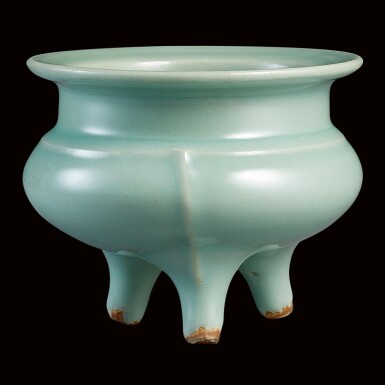Monochrome II
Monochrome II

A LONGQUAN CELADON TRIPOD INCENSE BURNER SOUTHERN SONG DYNASTY | 南宋 龍泉青釉鬲式爐
Auction Closed
October 9, 06:06 AM GMT
Estimate
1,800,000 - 2,500,000 HKD
Lot Details
Description
A LONGQUAN CELADON TRIPOD INCENSE BURNER
SOUTHERN SONG DYNASTY
南宋 龍泉青釉鬲式爐
with a compressed globular body rising to a constricted cylindrical neck and flat everted rim, all supported on three slightly splayed tapering legs, the rounded exterior with three evenly spaced ridges extending from the shoulder to the centre of each leg, superbly covered with a soft bluish-green glaze stopping short of the tips of the legs and exposing the pale grey body, Japanese wood box
d. 12.5 cm, 4 ¾ in.; h. 10.5 cm, 4 ⅛ in.
Collection of Tokiwayama Bunko Foundation, Tokyo.
常盤山文庫收藏,東京
The delicate celadon glaze and clear profile of this incense burner demonstrates the level of artistic and technical refinement achieved at the Longquan kilns during the Southern Song dynasty. Distributed in southern Zhejiang province, these kilns had been producing fine celadon wares in the preceding Northern Song period, although their popularity peaked after the move of the Song capital to Hangzhou in 1135. The support of the newly-established court and the kilns' ability to produce very fine wares, gave an unprecedented boost to the Longquan kilns. Both the court and scholar-officials that settled in Hangzhou favoured wares with seemingly modest forms but covered in mesmerising glazes with a depth of colour and tactility that resembled treasured jade. To recreate the jade-like appearance, craftsmen began replacing the traditional lime glaze used for making the celadon tone, with a lime-alkali glaze, which resulted in higher viscosity and softer gloss. The glaze was applied in multiple layers, thus appearing thick and lustrous.Longquan craftsmen were quick at adapting to the demands of the Southern Song dynasty, whose aesthetic ideals were well-rooted in Neo-Confucian philosophy. Neo-Confucianism gave rise to a centralised bureaucracy governed by scholar-officials selected through civil service examinations. A class of highly educated government officials, who displayed an increasing interest in China's Bronze Age, thus emerged. This led to a revival of antiquarianism and the study of antiques and history, which were considered a guiding principle in the pursuit of virtue. Potters at manufactories in southern China adopted these principles and introduced archaic forms into their repertoire. The form of the present censer, for example, was inspired by archaic bronze liding, food vessels with tri-lobed bodies supported on three legs.
Longquan censers of this form are held in important museums and private collections worldwide: two censers in the Palace Museum, Beijing, are illustrated in The Complete Collection of Treasures of the Palace Museum. Porcelain of the Song Dynasty (II), Hong Kong, 1999, pls 121 and 122; and one in the Tokyo, National Museum, is published in Oriental Ceramics. The World's Great Collections, vol. 1, Tokyo, 1982, pl. 97.
青瓷鬲式爐,釉翠瑩華,線條俐潔,盡顯南宋龍泉窰之精湛技術與藝術成就。龍泉窰位於浙江南方一帶,北宋時期已以燒造質精青瓷聞名,1135年宋室南遷杭州之後,更是發展蓬勃,精益求精。南宋皇室、文人傾慕青瓷,造形簡約,釉質如玉,豐美潤澤,雋永無窮。為追求更柔潤光華之釉色,瓷匠調整釉藥配方,加強石灰鹼值,以增青釉光潤感,施釉多反覆澆淋,增加厚度,更顯腴美。 南宋龍泉匠人依從當代儒人審美追求,汲古適今,取材高古青銅器形,本品鬲式爐造形可溯自青銅鬲鼎,器身均分三瓣、三足立之,原為盛裝食物的禮器。
類同龍泉青釉鬲式爐,藏於世界大型博物館及重要私人收藏:北京故宮博物院藏二例,刊於《故宮博物院藏文物珍品全集.兩宋瓷器(下)》,香港,1996年,卷2,圖版121、122;東京國立博物館藏一爐,錄於《東洋陶磁大觀》,卷1,東京,1982年,圖版97;第四例出自林原一郎舊藏,曾二度售於倫敦蘇富比,2012年11月7日,編號220,2019年5月15日,編號19 [https://www.sothebys.com/es/auctions/ecatalogue/2019/important-chinese-art-l19210/lot.19.html]。
